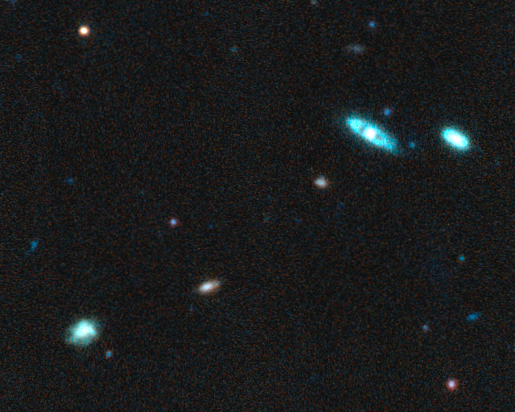Data from the James Webb Space Telescope (JWST) is coming in hot and heavy at this point, with various data streams from multiple instruments being reported in various papers. One exciting one will be released shortly in the Astrophysical Journal from researchers at the University of Kansas (KU), where researchers collected mid-infrared images of a part of the sky that holds galaxies from the time of the "cosmic noon" about 10 billion years ago. Their paper describes this survey and invites citizen scientists to help catalogue and classify some of their findings.
The project, known as the MIRI EGS Galaxy and AGN (MEGA) survey, packs acronyms on top of acronyms. MIRI is one of the primary JWST instruments, the Mid-Infrared Instrument, whose primary job is to observe the universe in the mid-infrared range. These frequencies have the advantage of being able to peer through the cosmic dust that inhabits much of the universe, and inhibits astronomers from seeing what is behind it.
EGS in the acronym stands for the "Extended Groth Strip", named after Princeton physicist Edward Groth. This "strip" is a patch of the sky near the constellation Ursa Major that astronomers have widely studied because it is thought to be a "clean window" to observe galaxies that are far, far away, according to study author and KU professor Allison Kirkpatrick. Typically, plenty of dust obscures the 10,000 galaxies in the EGS, which is why MIRI is so helpful in collecting data on them.
 Galaxies of different types, as seen in the MEGA survey.
Galaxies of different types, as seen in the MEGA survey.
Credit - NASA / JWST / Backhaus
Some of those galaxies are thought to have active galactic nuclei, or AGN, the third sub-acronym in the MEGA acronym. These active nuclei are hotbeds of star formation during the "cosmic dawn" era of the universe, when that process kicked up a notch in intensity. According to Dr. Kirkpatrick, almost half of the stellar masses of modern-day stars in the Milky Way owe their existence to stars that were formed during that epoch. Studying AGNs could hold the clues to understanding how that star formation process worked.
Now that we've explained the acronyms, what does this survey look like? If you're familiar with the famous "Ultra-Deep Field" that Hubble took showing a multitude of galaxies at increasingly far distances, the image from the MEGA survey look remarkably similar. And, just like the UDF images, they were produced using a lot of additional labor, particularly that of Bren Backhaus, a post-doc at KU.
Dr. Backhaus describes in a press release from KU how she had to manipulate the images coming from JWST, particularly how she had to deal with "dead pixels" and scratches in the JWST images present in them all. Additionally, she had to slightly correct the images as the survey was taken using four different filters with different infrared wavelengths. Since the telescope moved just a bit between the times those images were taken, she had to adjust the images to align correctly. While she used software rather than manually editing the images like in days gone by, it still took a significant effort of post-processing to get something readable.
JWST surveys have brought plenty of new information - here's a collection Fraser describes from its second year in operation.
The results are some stunning images, which contain a plethora of new data on galaxies never seen before. The KU team is asking for the public's help as part of the survey. They released some of the images onto Zooniverse, the citizen science platform, under a project called Cosmic Collisions. They hope that the informed public can help them classify galaxies by their shapes and also point out any instances of merging galaxies, as those are particularly interesting to astronomers due to the unique physics involved.
The MEGA survey itself is ongoing as well, with about 50% more time scheduled to continue observations in the same field soon. In the meantime, as Dr. Kirkpatrick points out, her students will be busy analyzing the dataset from the survey in as many ways as possible, especially during the one-year exclusive use window before the dataset is released to the public. There will undoubtedly be many more papers to come from this survey—we'll just have to see what it finds.
Learn More:
KU -Galaxies at 'cosmic noon': Research gives deep dive into universe's wild growth spurt
Backhaus et al -MEGAMassAssembly with JWST: The MIRI EGSGalaxy and AGNSurvey
UT -JWST Cycle 4 Spotlight, Part 3: Supermassive Black Holes and Cosmic Noon
UT -JWST Reveals Star Formation at Cosmic Noon
 Universe Today
Universe Today
